Business Law Assignment: Negligence and Liability, S-LAW504, Item 2
VerifiedAdded on 2022/09/07
|7
|1345
|15
Homework Assignment
AI Summary
This business law assignment analyzes a case involving Bob, who operates a holiday camping ground. The assignment focuses on the tort of negligence, examining Bob's duty of care to holidaymakers concerning the maintenance of hiking trails. The analysis covers the elements of negligence: duty of care, breach of duty, and causation. The application section evaluates the liability of Bob in relation to injuries sustained by Greg, Mary, and Mary's mother, considering defenses such as voluntary assumption of risk and contributory negligence. The assignment references legal principles including the Civil Liability Act and relevant case law such as Donoghue v. Stevenson and Cork v Kirby Maclean to determine the outcomes for each party. The conclusion finds Bob negligent, but liable only to Mary, with a detailed discussion of the application of legal principles to the facts presented.
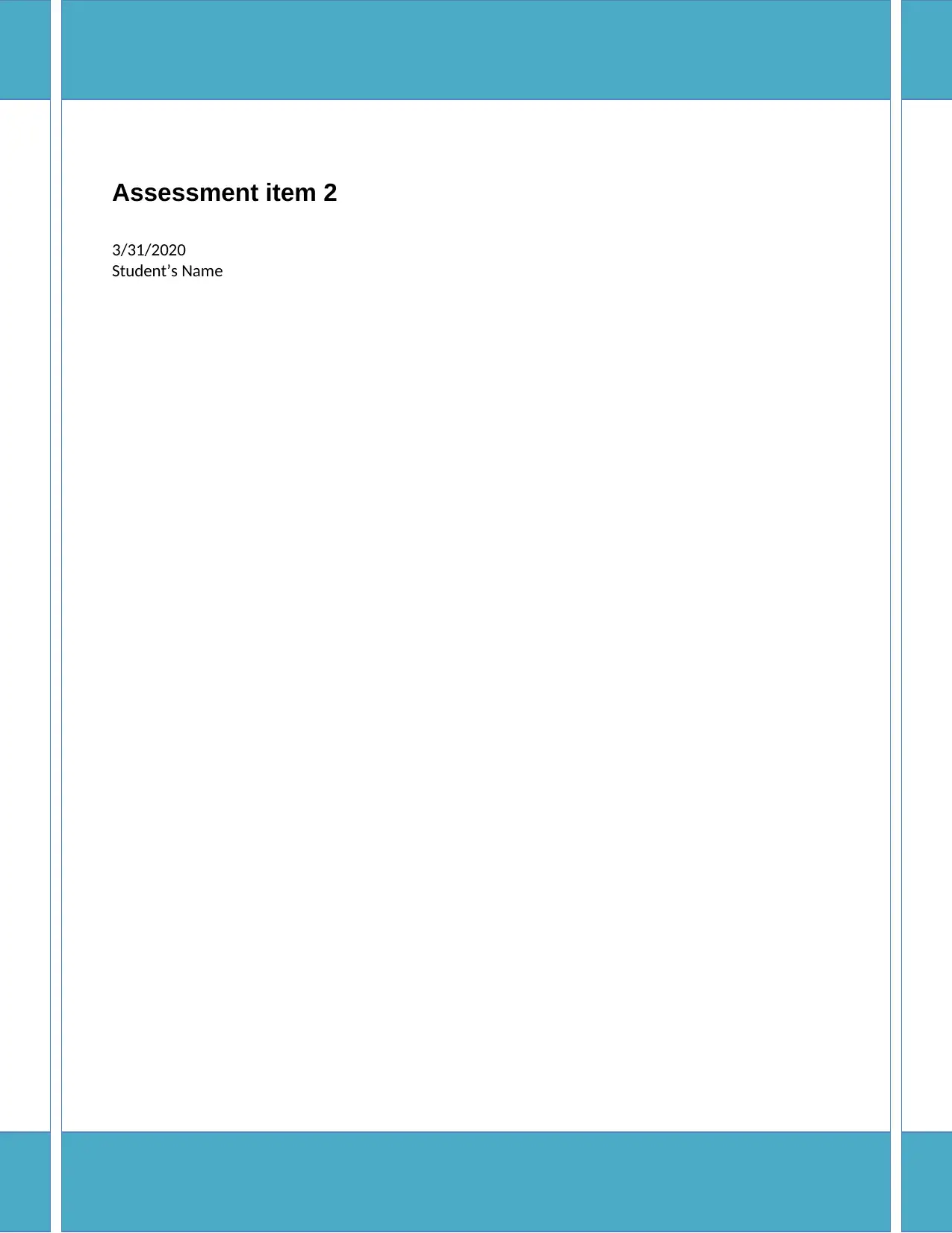
Running Head: BUSINESS LAW ASSIGNMENT 0
Assessment item 2
3/31/2020
Student’s Name
Assessment item 2
3/31/2020
Student’s Name
Paraphrase This Document
Need a fresh take? Get an instant paraphrase of this document with our AI Paraphraser
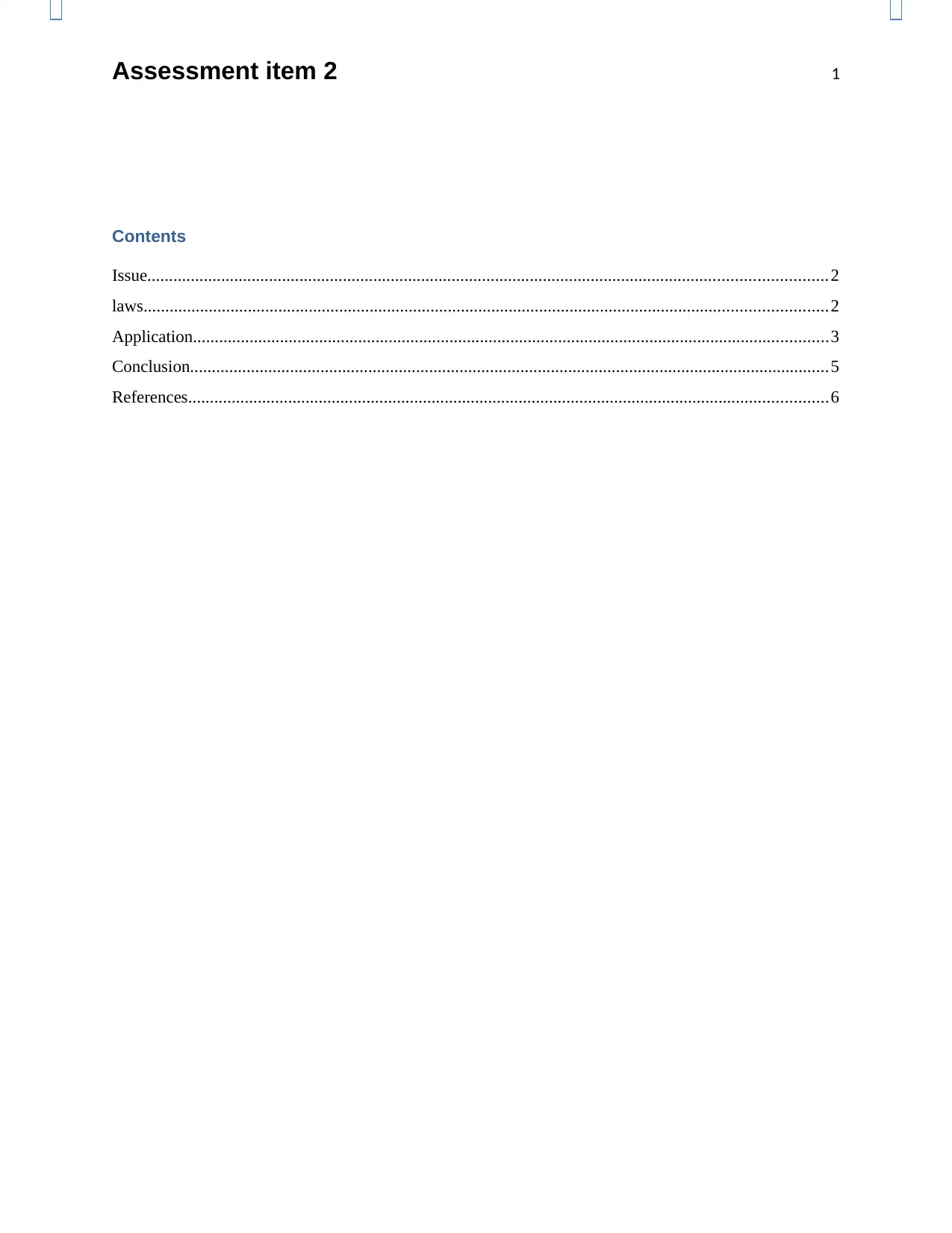
Assessment item 2 1
Contents
Issue............................................................................................................................................................2
laws.............................................................................................................................................................2
Application..................................................................................................................................................3
Conclusion...................................................................................................................................................5
References...................................................................................................................................................6
Contents
Issue............................................................................................................................................................2
laws.............................................................................................................................................................2
Application..................................................................................................................................................3
Conclusion...................................................................................................................................................5
References...................................................................................................................................................6
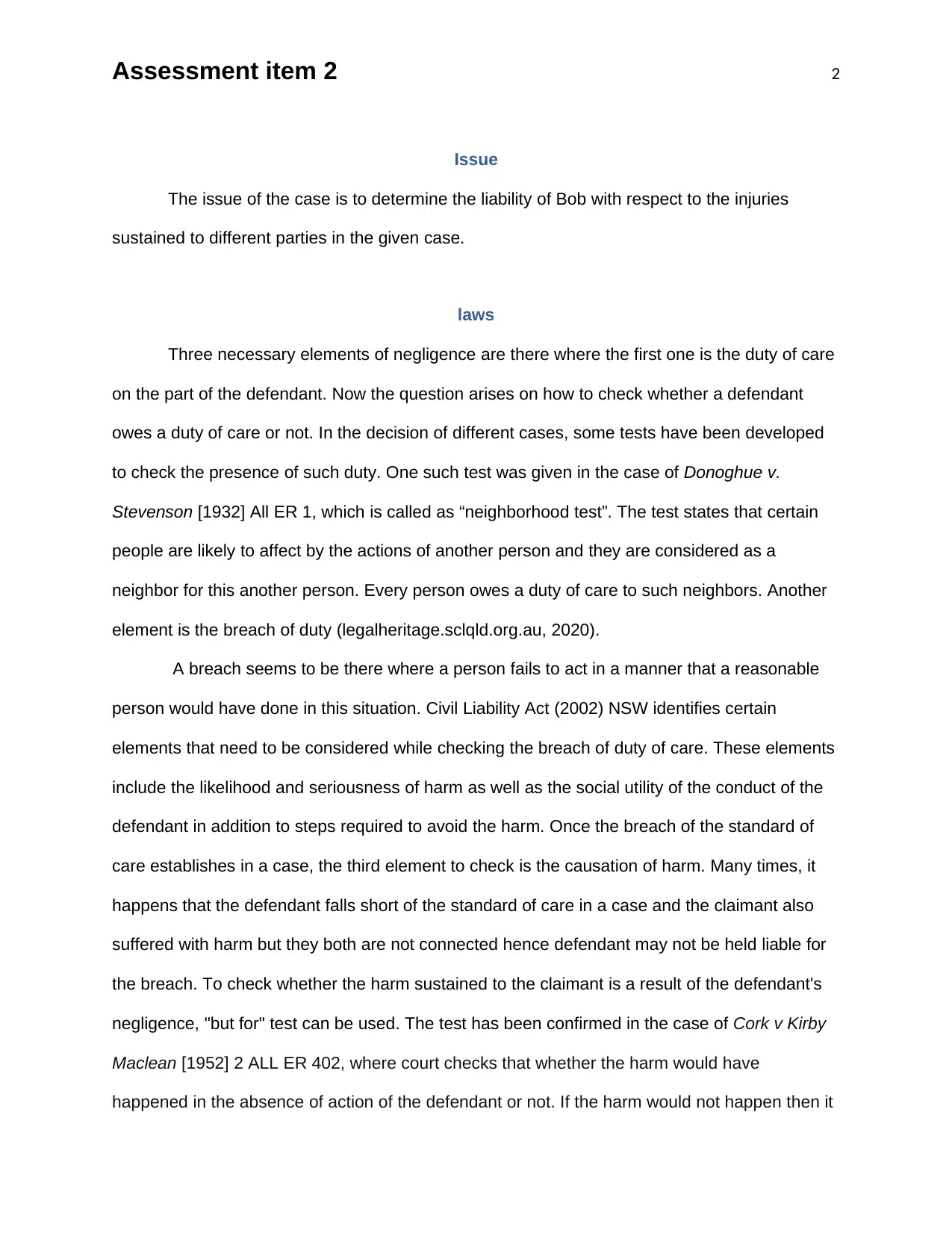
Assessment item 2 2
Issue
The issue of the case is to determine the liability of Bob with respect to the injuries
sustained to different parties in the given case.
laws
Three necessary elements of negligence are there where the first one is the duty of care
on the part of the defendant. Now the question arises on how to check whether a defendant
owes a duty of care or not. In the decision of different cases, some tests have been developed
to check the presence of such duty. One such test was given in the case of Donoghue v.
Stevenson [1932] All ER 1, which is called as “neighborhood test”. The test states that certain
people are likely to affect by the actions of another person and they are considered as a
neighbor for this another person. Every person owes a duty of care to such neighbors. Another
element is the breach of duty (legalheritage.sclqld.org.au, 2020).
A breach seems to be there where a person fails to act in a manner that a reasonable
person would have done in this situation. Civil Liability Act (2002) NSW identifies certain
elements that need to be considered while checking the breach of duty of care. These elements
include the likelihood and seriousness of harm as well as the social utility of the conduct of the
defendant in addition to steps required to avoid the harm. Once the breach of the standard of
care establishes in a case, the third element to check is the causation of harm. Many times, it
happens that the defendant falls short of the standard of care in a case and the claimant also
suffered with harm but they both are not connected hence defendant may not be held liable for
the breach. To check whether the harm sustained to the claimant is a result of the defendant's
negligence, "but for" test can be used. The test has been confirmed in the case of Cork v Kirby
Maclean [1952] 2 ALL ER 402, where court checks that whether the harm would have
happened in the absence of action of the defendant or not. If the harm would not happen then it
Issue
The issue of the case is to determine the liability of Bob with respect to the injuries
sustained to different parties in the given case.
laws
Three necessary elements of negligence are there where the first one is the duty of care
on the part of the defendant. Now the question arises on how to check whether a defendant
owes a duty of care or not. In the decision of different cases, some tests have been developed
to check the presence of such duty. One such test was given in the case of Donoghue v.
Stevenson [1932] All ER 1, which is called as “neighborhood test”. The test states that certain
people are likely to affect by the actions of another person and they are considered as a
neighbor for this another person. Every person owes a duty of care to such neighbors. Another
element is the breach of duty (legalheritage.sclqld.org.au, 2020).
A breach seems to be there where a person fails to act in a manner that a reasonable
person would have done in this situation. Civil Liability Act (2002) NSW identifies certain
elements that need to be considered while checking the breach of duty of care. These elements
include the likelihood and seriousness of harm as well as the social utility of the conduct of the
defendant in addition to steps required to avoid the harm. Once the breach of the standard of
care establishes in a case, the third element to check is the causation of harm. Many times, it
happens that the defendant falls short of the standard of care in a case and the claimant also
suffered with harm but they both are not connected hence defendant may not be held liable for
the breach. To check whether the harm sustained to the claimant is a result of the defendant's
negligence, "but for" test can be used. The test has been confirmed in the case of Cork v Kirby
Maclean [1952] 2 ALL ER 402, where court checks that whether the harm would have
happened in the absence of action of the defendant or not. If the harm would not happen then it
⊘ This is a preview!⊘
Do you want full access?
Subscribe today to unlock all pages.

Trusted by 1+ million students worldwide
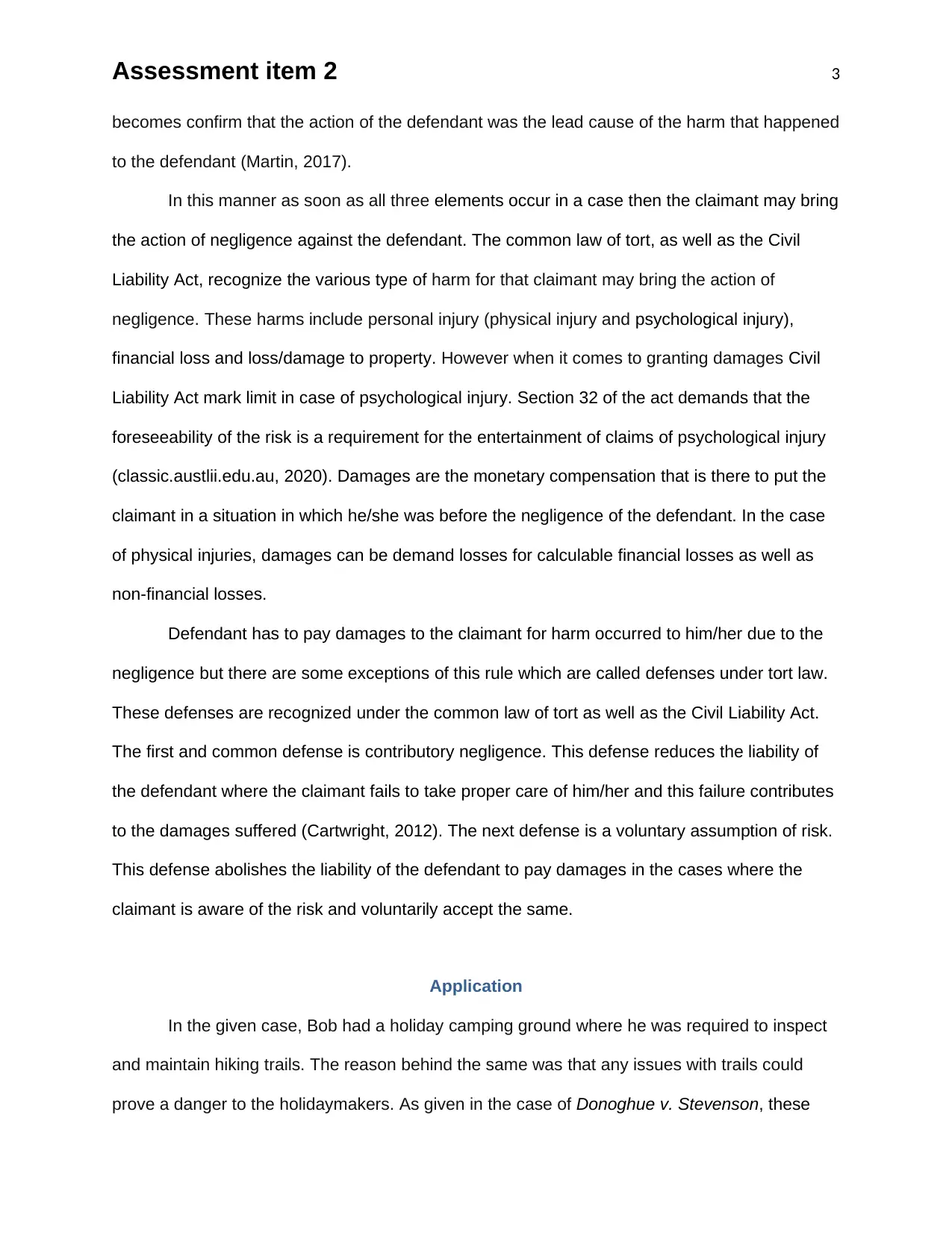
Assessment item 2 3
becomes confirm that the action of the defendant was the lead cause of the harm that happened
to the defendant (Martin, 2017).
In this manner as soon as all three elements occur in a case then the claimant may bring
the action of negligence against the defendant. The common law of tort, as well as the Civil
Liability Act, recognize the various type of harm for that claimant may bring the action of
negligence. These harms include personal injury (physical injury and psychological injury),
financial loss and loss/damage to property. However when it comes to granting damages Civil
Liability Act mark limit in case of psychological injury. Section 32 of the act demands that the
foreseeability of the risk is a requirement for the entertainment of claims of psychological injury
(classic.austlii.edu.au, 2020). Damages are the monetary compensation that is there to put the
claimant in a situation in which he/she was before the negligence of the defendant. In the case
of physical injuries, damages can be demand losses for calculable financial losses as well as
non-financial losses.
Defendant has to pay damages to the claimant for harm occurred to him/her due to the
negligence but there are some exceptions of this rule which are called defenses under tort law.
These defenses are recognized under the common law of tort as well as the Civil Liability Act.
The first and common defense is contributory negligence. This defense reduces the liability of
the defendant where the claimant fails to take proper care of him/her and this failure contributes
to the damages suffered (Cartwright, 2012). The next defense is a voluntary assumption of risk.
This defense abolishes the liability of the defendant to pay damages in the cases where the
claimant is aware of the risk and voluntarily accept the same.
Application
In the given case, Bob had a holiday camping ground where he was required to inspect
and maintain hiking trails. The reason behind the same was that any issues with trails could
prove a danger to the holidaymakers. As given in the case of Donoghue v. Stevenson, these
becomes confirm that the action of the defendant was the lead cause of the harm that happened
to the defendant (Martin, 2017).
In this manner as soon as all three elements occur in a case then the claimant may bring
the action of negligence against the defendant. The common law of tort, as well as the Civil
Liability Act, recognize the various type of harm for that claimant may bring the action of
negligence. These harms include personal injury (physical injury and psychological injury),
financial loss and loss/damage to property. However when it comes to granting damages Civil
Liability Act mark limit in case of psychological injury. Section 32 of the act demands that the
foreseeability of the risk is a requirement for the entertainment of claims of psychological injury
(classic.austlii.edu.au, 2020). Damages are the monetary compensation that is there to put the
claimant in a situation in which he/she was before the negligence of the defendant. In the case
of physical injuries, damages can be demand losses for calculable financial losses as well as
non-financial losses.
Defendant has to pay damages to the claimant for harm occurred to him/her due to the
negligence but there are some exceptions of this rule which are called defenses under tort law.
These defenses are recognized under the common law of tort as well as the Civil Liability Act.
The first and common defense is contributory negligence. This defense reduces the liability of
the defendant where the claimant fails to take proper care of him/her and this failure contributes
to the damages suffered (Cartwright, 2012). The next defense is a voluntary assumption of risk.
This defense abolishes the liability of the defendant to pay damages in the cases where the
claimant is aware of the risk and voluntarily accept the same.
Application
In the given case, Bob had a holiday camping ground where he was required to inspect
and maintain hiking trails. The reason behind the same was that any issues with trails could
prove a danger to the holidaymakers. As given in the case of Donoghue v. Stevenson, these
Paraphrase This Document
Need a fresh take? Get an instant paraphrase of this document with our AI Paraphraser
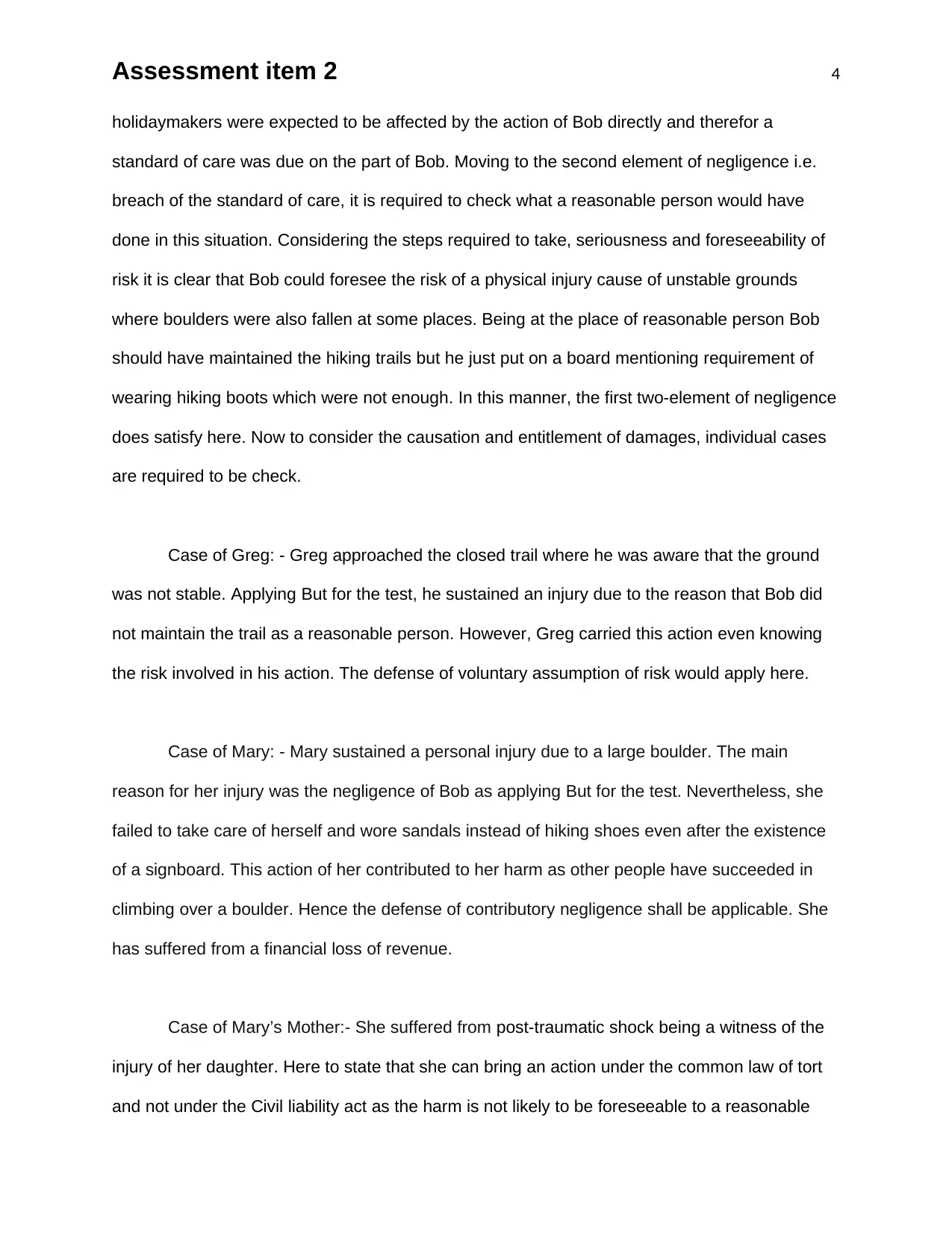
Assessment item 2 4
holidaymakers were expected to be affected by the action of Bob directly and therefor a
standard of care was due on the part of Bob. Moving to the second element of negligence i.e.
breach of the standard of care, it is required to check what a reasonable person would have
done in this situation. Considering the steps required to take, seriousness and foreseeability of
risk it is clear that Bob could foresee the risk of a physical injury cause of unstable grounds
where boulders were also fallen at some places. Being at the place of reasonable person Bob
should have maintained the hiking trails but he just put on a board mentioning requirement of
wearing hiking boots which were not enough. In this manner, the first two-element of negligence
does satisfy here. Now to consider the causation and entitlement of damages, individual cases
are required to be check.
Case of Greg: - Greg approached the closed trail where he was aware that the ground
was not stable. Applying But for the test, he sustained an injury due to the reason that Bob did
not maintain the trail as a reasonable person. However, Greg carried this action even knowing
the risk involved in his action. The defense of voluntary assumption of risk would apply here.
Case of Mary: - Mary sustained a personal injury due to a large boulder. The main
reason for her injury was the negligence of Bob as applying But for the test. Nevertheless, she
failed to take care of herself and wore sandals instead of hiking shoes even after the existence
of a signboard. This action of her contributed to her harm as other people have succeeded in
climbing over a boulder. Hence the defense of contributory negligence shall be applicable. She
has suffered from a financial loss of revenue.
Case of Mary’s Mother:- She suffered from post-traumatic shock being a witness of the
injury of her daughter. Here to state that she can bring an action under the common law of tort
and not under the Civil liability act as the harm is not likely to be foreseeable to a reasonable
holidaymakers were expected to be affected by the action of Bob directly and therefor a
standard of care was due on the part of Bob. Moving to the second element of negligence i.e.
breach of the standard of care, it is required to check what a reasonable person would have
done in this situation. Considering the steps required to take, seriousness and foreseeability of
risk it is clear that Bob could foresee the risk of a physical injury cause of unstable grounds
where boulders were also fallen at some places. Being at the place of reasonable person Bob
should have maintained the hiking trails but he just put on a board mentioning requirement of
wearing hiking boots which were not enough. In this manner, the first two-element of negligence
does satisfy here. Now to consider the causation and entitlement of damages, individual cases
are required to be check.
Case of Greg: - Greg approached the closed trail where he was aware that the ground
was not stable. Applying But for the test, he sustained an injury due to the reason that Bob did
not maintain the trail as a reasonable person. However, Greg carried this action even knowing
the risk involved in his action. The defense of voluntary assumption of risk would apply here.
Case of Mary: - Mary sustained a personal injury due to a large boulder. The main
reason for her injury was the negligence of Bob as applying But for the test. Nevertheless, she
failed to take care of herself and wore sandals instead of hiking shoes even after the existence
of a signboard. This action of her contributed to her harm as other people have succeeded in
climbing over a boulder. Hence the defense of contributory negligence shall be applicable. She
has suffered from a financial loss of revenue.
Case of Mary’s Mother:- She suffered from post-traumatic shock being a witness of the
injury of her daughter. Here to state that she can bring an action under the common law of tort
and not under the Civil liability act as the harm is not likely to be foreseeable to a reasonable
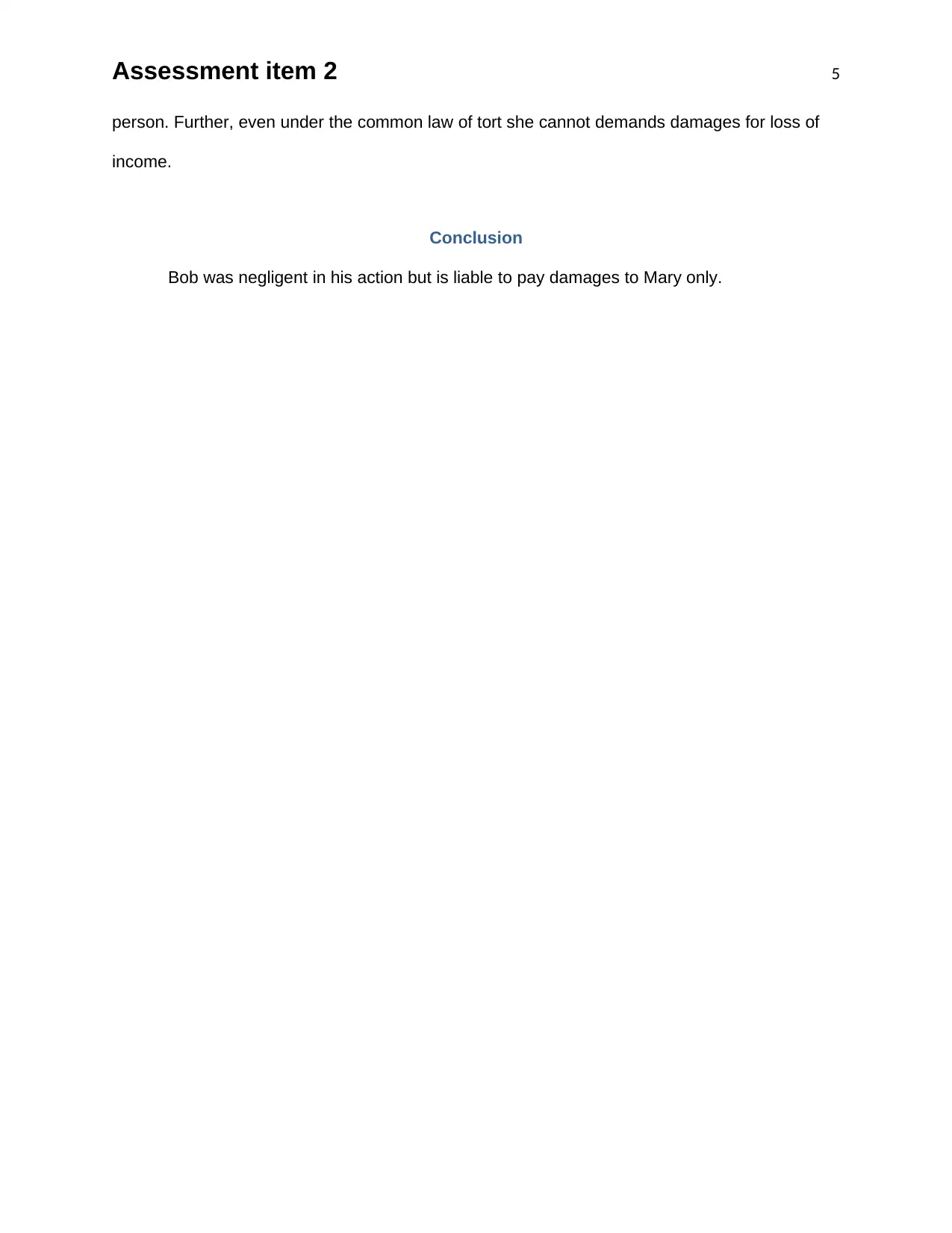
Assessment item 2 5
person. Further, even under the common law of tort she cannot demands damages for loss of
income.
Conclusion
Bob was negligent in his action but is liable to pay damages to Mary only.
person. Further, even under the common law of tort she cannot demands damages for loss of
income.
Conclusion
Bob was negligent in his action but is liable to pay damages to Mary only.
⊘ This is a preview!⊘
Do you want full access?
Subscribe today to unlock all pages.

Trusted by 1+ million students worldwide
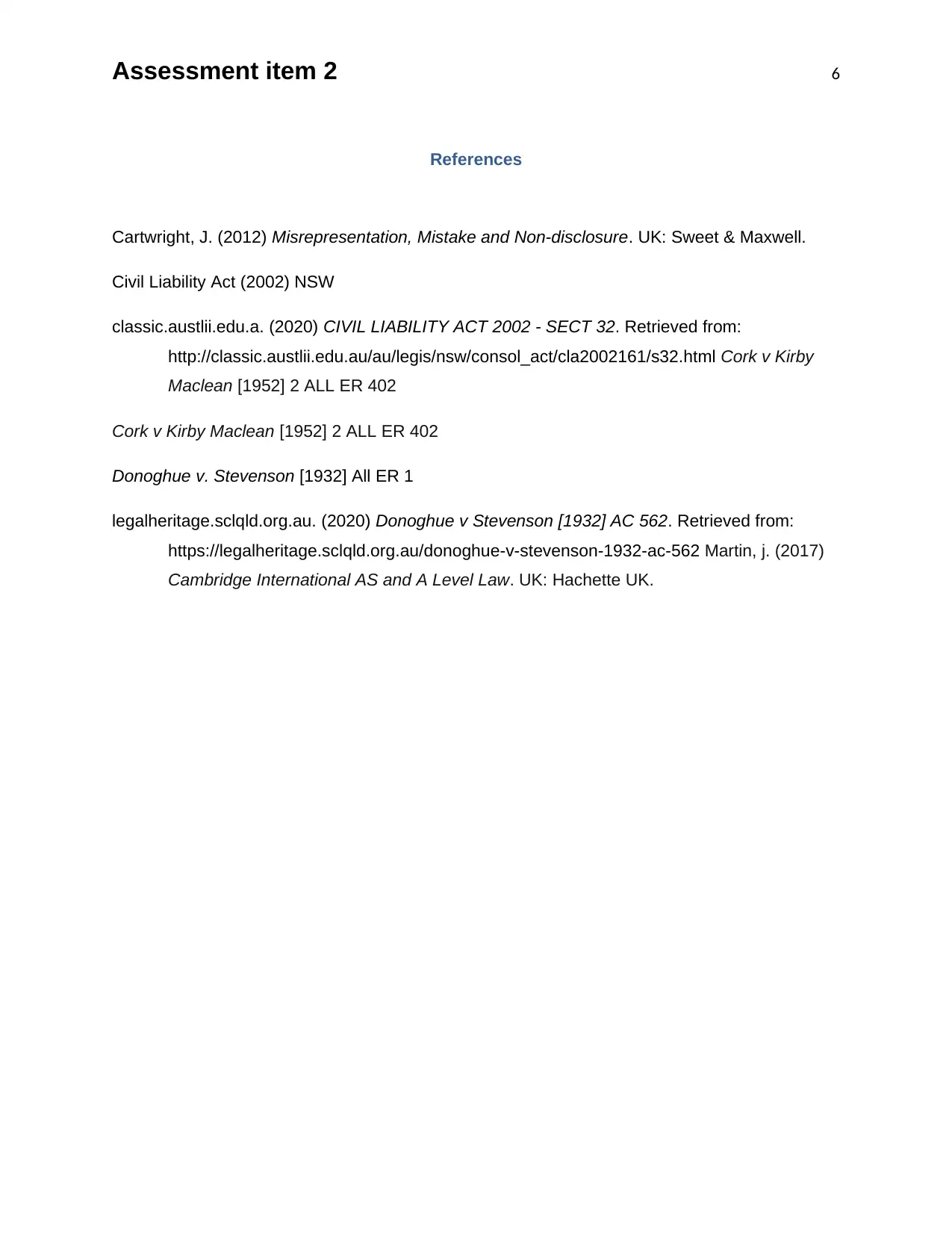
Assessment item 2 6
References
Cartwright, J. (2012) Misrepresentation, Mistake and Non-disclosure. UK: Sweet & Maxwell.
Civil Liability Act (2002) NSW
classic.austlii.edu.a. (2020) CIVIL LIABILITY ACT 2002 - SECT 32. Retrieved from:
http://classic.austlii.edu.au/au/legis/nsw/consol_act/cla2002161/s32.html Cork v Kirby
Maclean [1952] 2 ALL ER 402
Cork v Kirby Maclean [1952] 2 ALL ER 402
Donoghue v. Stevenson [1932] All ER 1
legalheritage.sclqld.org.au. (2020) Donoghue v Stevenson [1932] AC 562. Retrieved from:
https://legalheritage.sclqld.org.au/donoghue-v-stevenson-1932-ac-562 Martin, j. (2017)
Cambridge International AS and A Level Law. UK: Hachette UK.
References
Cartwright, J. (2012) Misrepresentation, Mistake and Non-disclosure. UK: Sweet & Maxwell.
Civil Liability Act (2002) NSW
classic.austlii.edu.a. (2020) CIVIL LIABILITY ACT 2002 - SECT 32. Retrieved from:
http://classic.austlii.edu.au/au/legis/nsw/consol_act/cla2002161/s32.html Cork v Kirby
Maclean [1952] 2 ALL ER 402
Cork v Kirby Maclean [1952] 2 ALL ER 402
Donoghue v. Stevenson [1932] All ER 1
legalheritage.sclqld.org.au. (2020) Donoghue v Stevenson [1932] AC 562. Retrieved from:
https://legalheritage.sclqld.org.au/donoghue-v-stevenson-1932-ac-562 Martin, j. (2017)
Cambridge International AS and A Level Law. UK: Hachette UK.
1 out of 7
Related Documents
Your All-in-One AI-Powered Toolkit for Academic Success.
+13062052269
info@desklib.com
Available 24*7 on WhatsApp / Email
![[object Object]](/_next/static/media/star-bottom.7253800d.svg)
Unlock your academic potential
Copyright © 2020–2025 A2Z Services. All Rights Reserved. Developed and managed by ZUCOL.





